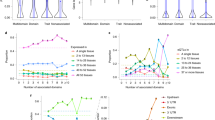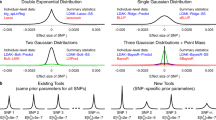Abstract
Difficulties in fine-mapping quantitative trait loci (QTLs) are a major impediment to progress in the molecular dissection of complex traits in mice. Here we show that genome-wide high-resolution mapping of multiple phenotypes can be achieved using a stock of genetically heterogeneous mice. We developed a conservative and robust bootstrap analysis to map 843 QTLs with an average 95% confidence interval of 2.8 Mb. The QTLs contribute to variation in 97 traits, including models of human disease (asthma, type 2 diabetes mellitus, obesity and anxiety) as well as immunological, biochemical and hematological phenotypes. The genetic architecture of almost all phenotypes was complex, with many loci each contributing a small proportion to the total variance. Our data set, freely available at http://gscan.well.ox.ac.uk, provides an entry point to the functional characterization of genes involved in many complex traits.
This is a preview of subscription content, access via your institution
Access options
Subscribe to this journal
Receive 12 print issues and online access
$209.00 per year
only $17.42 per issue
Buy this article
- Purchase on Springer Link
- Instant access to full article PDF
Prices may be subject to local taxes which are calculated during checkout




Similar content being viewed by others
Change history
04 August 2006
In the supplementary information initially published online to accompany this article, Supplementary Table 1 contained numerous errors. The original file has been replaced with a corrected version of the table. The error has been corrected online.
References
Flint, J., Valdar, W., Shifman, S. & Mott, R. Strategies for mapping and cloning quantitative trait genes in rodents. Nat. Rev. Genet. 6, 271–286 (2005).
Singer, J.B. et al. Genetic dissection of complex traits with chromosome substitution strains of mice. Science 304, 445–448 (2004).
Mott, R. & Flint, J. Simultaneous detection and fine mapping of quantitative trait loci in mice using heterogeneous stocks. Genetics 160, 1609–1618 (2002).
Mott, R., Talbot, C.J., Turri, M.G., Collins, A.C. & Flint, J. A method for fine mapping quantitative trait loci in outbred animal stocks. Proc. Natl. Acad. Sci. USA 97, 12649–12654 (2000).
Yalcin, B., Flint, J. & Mott, R. Using progenitor strain information to identify quantitative trait nucleotides in outbred mice. Genetics 171, 673–681 (2005).
Demarest, K., Koyner, J., McCaughran, J. Jr., Cipp, L. & Hitzemann, R. Further characterization and high-resolution mapping of quantitative trait loci for ethanol-induced locomotor activity. Behav. Genet. 31, 79–91 (2001).
Talbot, C.J. et al. High-resolution mapping of quantitative trait loci in outbred mice. Nat. Genet. 21, 305–308 (1999).
Talbot, C.J. et al. Fine scale mapping of a genetic locus for conditioned fear. Mamm. Genome 14, 223–230 (2003).
Balding, D.J. Discussion on the meeting on 'Statistical modelling and analysis of genetic data'. J. R. Stat. Soc. Ser. B Stat. Methodol. 64, 737–775 (2002).
Sillanpaa, M.J. & Corander, J. Model choice in gene mapping: what and why. Trends Genet. 18, 301–307 (2002).
Broman, K.W. & Speed, T.P. A model selection approach for the identification of quantitative trait loci in experimental crosses. J. R. Stat. Soc. Ser. B Stat. Methodol. 64, 641–656 (2002).
Ball, R.D. Bayesian methods for quantitative trait loci mapping based on model selection: approximate analysis using the Bayesian information criterion. Genetics 159, 1351–1364 (2001).
Solberg, L.C. et al. A protocol for high-throughput phenotyping, suitable for quantitative trait analysis in mice. Mamm. Genome 17, 129–146 (2006).
Breiman, L. Bagging predictors. Mach. Learn. 24, 123–140 (1996).
Hackett, C.A., Meyer, R.C. & Thomas, W.T.B. Multi-trait QTL mapping in barley using multivariate regression. Genet. Res. 77, 95–106 (2001).
Valdar, W. et al. Genetic and environmental effects on complex traits in mice. Genetics (in the press).
Visscher, P.M. & Haley, C.S. Detection of putative quantitative trait loci in line crosses under infinitesimal genetic models. Theor. Appl. Genet. 93, 691–702 (1996).
Yalcin, B. et al. Genetic dissection of a behavioral quantitative trait locus shows that Rgs2 modulates anxiety in mice. Nat. Genet. 36, 1197–1202 (2004).
Deutschbauer, A.M. & Davis, R.W. Quantitative trait loci mapped to single-nucleotide resolution in yeast. Nat. Genet. 37, 1333–1340 (2005).
Mackay, T.F. The genetic architecture of quantitative traits: lessons from Drosophila. Curr. Opin. Genet. Dev. 14, 253–257 (2004).
Darvasi, A. Experimental strategies for the genetic dissection of complex traits in animal models. Nat. Genet. 18, 19–24 (1998).
Dipetrillo, K., Wang, X., Stylianou, I.M. & Paigen, B. Bioinformatics toolbox for narrowing rodent quantitative trait loci. Trends Genet. 21, 683–692 (2005).
Doolittle, M.H., LeBoeuf, R.C., Warden, C.H., Bee, L.M. & Lusis, A.J. A polymorphism affecting lipoprotein A-II translational efficiency determines high density lipoprotein size and composition. J. Biol. Chem. 256, 16380–16388 (1990).
Warden, C.H., Hedrick, C.C., Qiao, J.H., Castellani, L.W. & Lusis, A.J. Atherosclerosis in transgenic mice overexpressing apoliprotein A-II. Science 261, 469–472 (1993).
Wang, X., Korstanje, R., Higgins, D. & Paigen, B. Haplotype analysis in multiple crosses to identify a QTL gene. Genome Res. 14, 1767–1772 (2004).
Foreman, J.E. et al. Serum alkaline phosphatase activity is regulated by a chromosomal region containing the alkaline phosphatase 2 gene (Akp2) in C57BL/6J and DBA/2J mice. Physiol. Genomics 23, 295–303 (2005).
Chesler, E.J. et al. Complex trait analysis of gene expression uncovers polygenic and pleiotropic networks that modulate nervous system function. Nat. Genet. 37, 233–242 (2005).
Schadt, E.E. et al. An integrative genomics approach to infer causal associations between gene expression and disease. Nat. Genet. 37, 710–717 (2005).
R Development Core Team. A Language and Environment for Statistical Computing (R Foundation for Statistical Computing, Vienna, 2004).
Cervino, A.C. et al. Integrating QTL and high-density SNP analyses in mice to identify Insig2 as a susceptibility gene for plasma cholesterol levels. Genomics 86, 505–517 (2005).
Wiltshire, T. et al. Genome-wide single-nucleotide polymorphism analysis defines haplotype patterns in mouse. Proc. Natl. Acad. Sci. USA 100, 3380–3385 (2003).
Petkov, P.M. et al. Evidence of a large-scale functional organization of mammalian chromosomes. PLoS Genet. 1, e33 (2005).
Valdar, W., Flint, J. & Mott, R. Simulating the collaborative cross: power of QTL detection and mapping resolution in large sets of recombinant inbred strains of mice. Genetics 172, 1783–1797 (2006).
Visscher, P.M., Thompson, R. & Haley, C.S. Confidence intervals in QTL mapping by bootstrapping. Genetics 143, 1013–1020 (1996).
Toye, A.A. et al. A genetic and physiological study of impaired glucose homeostasis control in C57BL/6J mice. Diabetologia 48, 675–686 (2005).
Caldarone, B. et al. Quantitative trait loci analysis affecting contextual conditioning in mice. Nat. Genet. 17, 335–337 (1997).
Wehner, J.M. et al. Quantitative trait locus analysis of contextual fear conditioning in mice. Nat. Genet. 17, 331–334 (1997).
Ackerman, K.G. et al. Interacting genetic loci cause airway hyperresponsiveness. Physiol. Genomics 21, 105–111 (2005).
Henderson, N.D., Turri, M.G., DeFries, J.C. & Flint, J. QTL Analysis of multiple behavioral measures of anxiety in mice. Behav. Genet. 34, 267–293 (2004).
Cohen, R.M., Kang, A. & Gulick, C. Quantitative trait loci affecting the behavior of A/J and CBA/J intercross mice in the elevated plus maze. Mamm. Genome 12, 501–507 (2001).
Wang, X. & Paigen, B. Genetics of variation in HDL cholesterol in humans and mice. Circ. Res. 96, 27–42 (2005).
Gershenfeld, H.K. et al. Mapping quantitative trait loci for open-field behavior in mice. Behav. Genet. 27, 201–210 (1997).
Singer, J.B., Hill, A.E., Nadeau, J.H. & Lander, E.S. Mapping quantitative trait loci for anxiety in chromosome substitution strains of mice. Genetics 169, 855–862 (2005).
Steinberger, D. et al. Genetic mapping of variation in spatial learning in the mouse. J. Neurosci. 23, 2426–2433 (2003).
De Sanctis, G.T. et al. Quantitative locus analysis of airway hyperresponsiveness in A/J and C57BL/6J mice. Nat. Genet. 11, 150–154 (1995).
Ewart, S.L. et al. Quantitative trait loci controlling allergen-induced airway hyperresponsiveness in inbred mice. Am. J. Respir. Cell Mol. Biol. 23, 537–545 (2000).
Morris, K.H., Ishikawa, A. & Keightley, P.D. Quantitative trait loci for growth traits in C57BL/6J x DBA/2J mice. Mamm. Genome 10, 225–228 (1999).
Taylor, B.A. & Phillips, S.J. Obesity QTLs on mouse chromosomes 2 and 17. Genomics 43, 249–257 (1997).
Acknowledgements
This work was supported by grants from The Wellcome Trust and the European Union (contract LHSG-CT-2003-503265). D.G. holds a Wellcome senior fellowship in basic biomedical science (057733). We are grateful to R. Hitzemann for providing heterogeneous stock mice, to M. Daly and R. Williams for help with SNP selection and to S. McCormick and A. Morris for comments on the manuscript.
Author information
Authors and Affiliations
Contributions
The heterogeneous stock study was designed by J.F., R.M., W.O.C., L.C.S., D.G. and J.N.P.R. Phenotype and genotype assessments were performed by S.B., P.K., J.F. and L.C.S. W.V., M.S.T., J.F. and R.M. were responsible for the analysis. All authors contributed to the writing of the paper.
Corresponding authors
Ethics declarations
Competing interests
The authors declare no competing financial interests.
Supplementary information
Supplementary Figure 1
Distribution of the number of genes contained within 50% confidence intervals of 843 QTLs. (PDF 113 kb)
Supplementary Table 1
QTLs with bootstrap posterior probabilities (BPP) values > 0.25 (XLS 356 kb)
Supplementary Table 2
Sex-specific QTLs (found by a genome scan for sex by genotype interaction) that exceed logP 5. (XLS 39 kb)
Rights and permissions
About this article
Cite this article
Valdar, W., Solberg, L., Gauguier, D. et al. Genome-wide genetic association of complex traits in heterogeneous stock mice. Nat Genet 38, 879–887 (2006). https://doi.org/10.1038/ng1840
Received:
Accepted:
Published:
Issue Date:
DOI: https://doi.org/10.1038/ng1840
This article is cited by
-
Dominance is common in mammals and is associated with trans-acting gene expression and alternative splicing
Genome Biology (2023)
-
Analyzing Multiple Phenotypes Based on Principal Component Analysis
Acta Mathematicae Applicatae Sinica, English Series (2022)
-
Grouping of genomic markers in populations with family structure
BMC Bioinformatics (2021)
-
Genome-wide association study reveals the genetic determinism of growth traits in a Gushi-Anka F2 chicken population
Heredity (2021)
-
Discovering weaker genetic associations guided by known associations
BMC Medical Genomics (2020)



